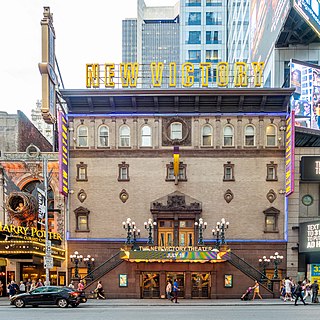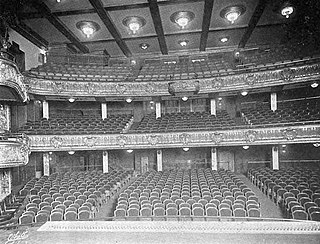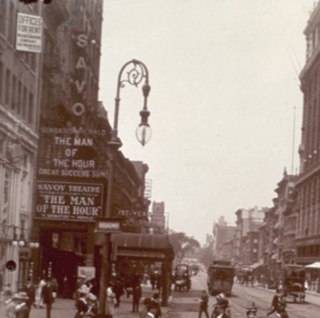
Ruth Chatterton was an American stage, film, and television actress, aviator and novelist. She was at her most popular in the early to mid-1930s, and in the same era gained prominence as an aviator, one of the few female pilots in the United States at the time. In the late 1930s, Chatterton retired from film acting but continued her career on the stage. She had several TV roles beginning in the late 1940s and became a successful novelist in the 1950s.

Arthur Reed Ropes, better known under the pseudonym Adrian Ross, was a prolific writer of lyrics, contributing songs to more than sixty British musical comedies in the late 19th and early 20th centuries. He was the most important lyricist of the British stage during a career that spanned five decades. At a time when few shows had long runs, nineteen of his West End shows ran for over 400 performances.

The Gaiety Theatre was a West End theatre in London, located on Aldwych at the eastern end of the Strand. The theatre was first established as the Strand Musick Hall in 1864 on the former site of the Lyceum Theatre. In 1868, it became known as the Gaiety Theatre and was, at first, known for music hall and then for musical burlesque, pantomime and operetta performances. From 1868 to the 1890s, it had a major influence on the development of modern musical comedy.

The Hippodrome Theatre, also called the New York Hippodrome, was a theater located on Sixth Avenue between West 43rd and West 44th Streets in the Theater District of Midtown Manhattan in New York City. The theater operated from 1905 to 1939 and was called the world's largest theater by its builders, with a seating capacity of 5,300 and a stage measuring 100 by 200 feet. It had state-of-the-art theatrical technology, including a rising glass water tank.

George Grossmith Jr. was an English actor, theatre producer and manager, director, playwright and songwriter, best remembered for his work in and with Edwardian musical comedies. Grossmith was also an important innovator in bringing "cabaret" and "revues" to the London stage. Born in London, he took his first role on the musical stage at the age of 18 in Haste to the Wedding (1892), a West End collaboration between his famous songwriter and actor father and W. S. Gilbert.

Cecilia Loftus was a Scottish actress, singer, mimic, vaudevillian, and music hall performer in the late 19th and early 20th centuries.

The New Victory Theater is a theater at 209 West 42nd Street in the Theater District of Midtown Manhattan in New York City, near Times Square. Built in 1900 as the Republic Theatre, it was designed by Albert Westover and developed by Oscar Hammerstein I as a Broadway theater. The theater has been known by several names over the years, including the Belasco Theatre, Minsky's Burlesque, and the Victory Theatre. The theater is owned by the city and state governments of New York and leased to nonprofit New 42, which has operated the venue as a children's theater since 1995. The New Victory presents theater shows, dance shows, puppet shows, and other types of performance art shows from all around the world.

Frank Parish Conroy was a British film and stage actor who appeared in many films, notably Grand Hotel (1932), The Little Minister (1934) and The Ox-Bow Incident (1943).
Margaret Hart Ferraro, better known as Margie Hart, was a New York City stripteaser, in American burlesque theatre.

The 44th Street Theatre was a Broadway theater at 216 West 44th Street in the Theater District of Manhattan in New York City from 1912 to 1945. It was originally named Weber and Fields' Music Hall when it opened in November 1912 as a resident venue for the comedy duo Weber and Fields, but was renamed to the 44th Street Theatre in December 1913 after their tenure at the theatre ended. It should not be confused with the Weber and Fields' Broadway Music Hall, often referred to as simply Weber and Fields' Music Hall and also known as Weber's Music Hall or Weber's Theatre, which was used by both Weber and Fields or just Weber from 1896 through 1912.

Charles Waldron was an American stage and film actor, sometimes credited as Charles Waldron Sr., Chas. Waldron Sr., Charles D. Waldron or Mr. Waldron.

The Garrick Theatre was a 910-seat theatre built in 1890 and located on 67 West 35th Street in Manhattan, New York City. Designed by Francis Hatch Kimball, it was commissioned by Edward Harrigan, who also managed the theatre, originally named Harrigan's Theatre, until 1895. Richard Mansfield took over from Harrigan, renaming it the Garrick. Charles Frohman assumed management from 1896 until 1915. The Shuberts bought it in 1916 and leased it to Otto Kahn, who named it Théâtre du Vieux-Colombier, after a theatre in Paris of the same name. Kahn later gave it to the Theatre Guild and it resumed the name Garrick Theatre in 1919. The Shuberts resumed management in 1925 and the theatre closed as a playhouse in 1929. After a short run of burlesque, the building was demolished in 1932.
Isidore H. Herk was a burlesque manager who played a major role in the evolution of this entertainment before World War II. His show at the Gaiety Theatre, closed in 1941, was the last burlesque show on Broadway.

The Columbia Theatre was an American burlesque theater on Seventh Avenue at the north end of Times Square in Midtown Manhattan, New York City. Operated by the Columbia Amusement Company between 1910 and 1927, it specialized in "clean", family-oriented burlesque, similar to vaudeville. Many stars of the legitimate theater or of films were discovered at the Columbia. With loss of audiences to cinema and stock burlesque, the owners began to offer slightly more risqué material from 1925. The theater was closed in 1927, renovated and reopened in 1930 as a cinema called the Mayfair Theatre. It went through various subsequent changes and was later renamed the DeMille Theatre. Nothing is left of the theater.
The Comedy Theatre was a Broadway theatre located at 110 West 41st Street in Manhattan that opened in 1909. It presented the first Broadway appearances of Katharine Cornell and Ruth Draper, as well as Eugene O'Neill's first Broadway play. Shuttered in the wake of the Depression, it reopened in 1937 as the Mercury Theatre — the venue for Orson Welles's groundbreaking adaptation of Shakespeare's Julius Caesar and other productions for the Mercury Theatre repertory company. In 1939 it began presenting classic Yiddish theatre. The building was demolished in 1942.

Hotel Victoria was built by Paran Stevens in 1877 in Manhattan, New York City, New York. Occupying the entire block on 27th Street, Broadway and Fifth Avenue, it was the only hotel in the city with entrances on both the latter thoroughfares. The hotel was owned by the American Hotel Victoria Company. George W. Sweeney served as president and Angus Gordon was manager. In 1911, it was announced that the hotel had been redecorated, renovated, and refurnished at a cost of $250,000. Room options included without bath, with bath, and suites with rates ranging between $1.50 and $6.00 per day. Accommodations were available for 500 guests.

George M. Cohan's Theatre was a Broadway theatre at Broadway and West 43rd Street in the Midtown Manhattan neighborhood of New York City. It was built in 1911 and demolished in 1938.

The Savoy Theatre was a Broadway theatre at 112 West 34th Street in Midtown Manhattan, New York City. It opened in 1900. It was converted to a cinema around 1910, until it was closed in early 1952 and then demolished.
Daddy-Long-Legs is a 1914 play by the American writer Jean Webster. Webster adapted it from her own 1912 epistolary novel Daddy-Long-Legs.
The Circle Theatre was a Broadway theatre, concert hall, movie theatre, and venue for vaudeville and burlesque located at the corner of Broadway and West 60th Street. It was the first theatre built in the Columbus Circle area of Manhattan. It's address was 1825 Broadway.
















